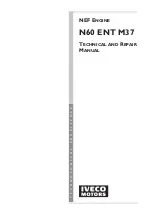
14
ENGINE SYSTEMS
Turbochargers
Figure 4
High and Low Pressure Turbocharger Components – Inner and Outer views
1.
High Pressure (HP) turbocharger
compressor inlet
2.
HP turbocharger turbine inlet
3.
LP turbocharger turbine outlet
4.
HP turbocharger
5.
HP turbocharger wastegate
actuator
6.
Low Pressure (LP) turbocharger
7.
Turbocharger oil supply tube
8.
LP turbocharger compressor
outlet
9.
Oil return tube
10. LP turbocharger compressor
inlet
11. HP turbocharger compressor
outlet
Navistar
®
N13
engines
are
equipped
with
a
pneumatically
regulated
two-stage
turbocharger
system. The High Pressure (HP) and Low Pressure
(LP) turbochargers are installed in parallel on the right
side of the engine.
Intake air flow:
Filtered air enters the LP compressor,
where it is compressed and directed to the Low
Pressure Charge Air Cooler (LPCAC). Cooled
compressed air then enters the HP compressor,
where it is further compressed and directed into
the High Pressure Charge Air Cooler (HPCAC).
Compressed air then goes through the Engine
Throttle Valve (ETV) and the intake throttle duct. This
system provides high charge air pressure to improve
engine performance and to help reduce emissions.
Exhaust gas flow:
The HP turbocharger is
connected to the exhaust manifold through the HP
turbine inlet.
Exhaust gases exit the HP turbine
outlet and are directed to the LP turbine inlet. The
HP turbocharger is equipped with a wastegate,
which is controlled by a pneumatic actuator. The HP
turbocharger wastegate is used to regulate boost by
controlling the amount of exhaust gas that bypasses
the turbine of the turbocharger. When boost demand


































